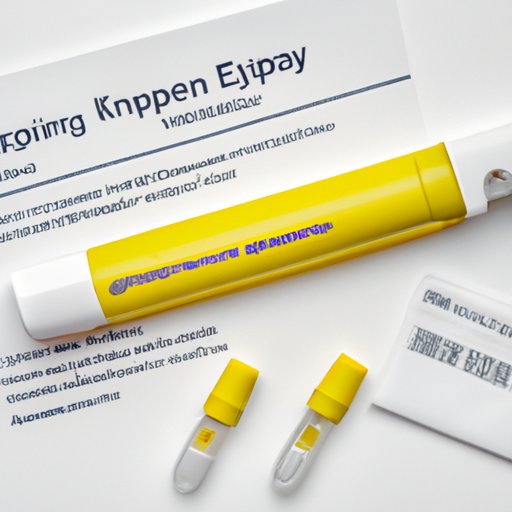
I. Introduction
An EpiPen is a life-saving tool that can help prevent severe allergic reactions from becoming fatal. It’s important to know how to use an EpiPen properly, whether for yourself or someone else in an emergency situation. This article will cover everything you need to know about using an EpiPen, including a step-by-step guide, real-life scenarios, personal stories, FAQs, and more.
II. Step-by-Step Guide
Using an EpiPen may seem daunting, but it’s actually quite simple, especially if you are prepared in advance. Here are the basic steps to follow:
- Remove the EpiPen from the plastic case
- Hold the EpiPen in your dominant hand with the orange tip facing downwards
- Remove the blue safety release by pulling it straight up with your other hand, being careful not to touch the orange tip
- Place the orange tip against the middle of the outer thigh, pressing down firmly until it clicks
- Hold the EpiPen in place for 3-10 seconds to ensure all the medication is injected
- Remove the EpiPen and massage the injection site for 10 seconds
- Seek emergency medical attention immediately, even if symptoms begin to improve
It’s important to note that an EpiPen is a one-time use only tool, so be sure to use it effectively to maximize its effects.
If you are using an EpiPen on someone else, be sure to check if they are carrying one with them and if they have any specific instructions for its usage. It’s also important to inform medical professionals of the situation and let them know when the EpiPen was used.
III. Scenarios
Many scenarios can trigger severe allergic reactions, including insect bites or stings, food, and medications. Here are some common situations and how to use an EpiPen properly:
Insect Bites or Stings
If someone experiences an allergic reaction to an insect bite or sting and shows symptoms such as hives, swelling, and difficulty breathing, it’s important to use an EpiPen as soon as possible.
- Follow the steps from the Step-by-Step Guide.
- Check for any signs of improvement in the person’s condition. If necessary, apply an ice pack to the injection site
- Call for emergency medical attention to take the person to the hospital
- Stay with the person until medical help arrives
Food Allergies
If someone has food allergies and experiences symptoms such as difficulty breathing, vomiting, or swelling of the mouth or throat, use an EpiPen immediately.
- Follow the steps from the Step-by-Step Guide.
- Call for emergency medical attention to transport the person to the hospital
- Stay with the person until medical professionals arrive
IV. Infographic
Visual aids can be incredibly helpful in emergency situations. Here’s an easy-to-follow infographic that shows how to use an EpiPen:
Insert Image of Infographic
It’s important to note that this graphic is meant as a supplement to the step-by-step guide and should not be solely relied on in an emergency situation.
V. Personal Testimonies
Using an EpiPen can be a scary experience, but hearing from others who have gone through it can be reassuring. Here are some personal stories and tips for managing stress around using an EpiPen:
“I Never Thought it Would Happen to Me”
“I have been carrying an EpiPen with me for years and never had to use it until one day, I felt my throat start to close up after eating a salad with nuts in it. I was with my friends, so they knew what to do and used my EpiPen. It was a scary experience, but I’m grateful I had it with me. My advice is to always carry your EpiPen and be prepared for any situation.”
“Don’t Panic”
“It’s easy to get overwhelmed in an emergency situation, but it’s important to remain calm and follow the steps you were trained to do. Practice using your EpiPen, so you feel more confident if you need to use it in a high-pressure scenario.”
VI. FAQs
Here are some frequently asked questions about EpiPens:
Can I use an expired EpiPen if I don’t have a new one?
No, an expired EpiPen should not be used. It’s essential to replace your EpiPen when you reach the expiration date or earlier if it becomes discolored or cloudy.
How should I store my EpiPen?
EpiPens should be stored at room temperature and not be exposed to extreme heat or cold.
Can I use someone else’s EpiPen if I don’t have mine?
No, EpiPens are prescribed to individuals with specific dosage information and should not be shared.
VII. Medicine Management
Being prepared for an emergency involves more than just knowing how to use your EpiPen. Here are some tips for managing medication and staying organized:
Keep an Emergency Kit Handy
In addition to your EpiPen, consider carrying other emergency medications, like Benadryl, and make sure they are not expired.
Communicate with Your Healthcare Provider
Let your doctor know that you carry an EpiPen and share any relevant medical history or allergies. They can also help you create an emergency action plan.
VIII. History and Development
The EpiPen was invented in the mid-1970s by a biomedical engineer and his physician partner who were looking for a way to provide faster relief to patients experiencing severe allergic reactions. The first EpiPen was approved by the FDA in 1987, and since then, it has become a widely used tool for allergy treatment. Fun fact: the original EpiPen was the size of a large flashlight!
IX. Conclusion
Knowing how to use an EpiPen properly is crucial for managing and preventing severe allergic reactions. This article has covered everything you need to know, from a step-by-step guide to real-life scenarios to personal stories and beyond. Remember to replace your EpiPen when it expires, carry other emergency medications if necessary, and never be afraid to seek medical attention in an emergency. Stay safe and stay prepared.





